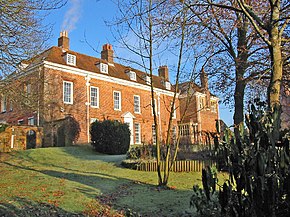Lyndhurst (Hampshire)
| Lyndhurst | ||
|---|---|---|
| Lyndhurst town center | ||
| Coordinates | 50 ° 52 ′ N , 1 ° 35 ′ W | |
|
|
||
| Residents | 2973 | |
| administration | ||
| Post town | Lyndhurst | |
| ZIP code section | SO43 | |
| prefix | 023 | |
| Part of the country | England | |
| region | South East England | |
| Shire county | Hampshire | |
| District | New Forest | |
| Website: [1] | ||
Lyndhurst is a small town of about 3,000 inhabitants in the district of New Forest in the county of Hampshire in southern England . The name Lyndhurst means something like "hill forested with linden trees".
location
Lyndhurst is located about 90 miles or 145 kilometers (driving distance) southwest of London in the middle of the former royal hunting ground and today's New Forest National Park . The nearest major city is Southampton, about 10 miles or 16 kilometers east . The two historic towns of Winchester and Salisbury are located approximately 20 miles or 36 kilometers to the northeast and northwest, respectively.
economy
The economic life of the small town was dependent on agriculture in the area for centuries. Traders as well as handicraft and service companies (barbers, restaurants, etc.) settled here as early as the Middle Ages. Today tourism plays a major role in the city's economic life.
history
The place is first mentioned in 1086 as Lynhest in the Domesday Book . In the Middle Ages it belonged to the manor of a family of the same name ( Lyndhurst Family ), but fell back to the English crown in 1270. Thereafter, Lyndhurst belonged to the dowry of four different English queens ( Eleanor of Castile , Margaret of France , Isabelle de France and Philippa of Hainaut ) for about 100 years before the place became crown possession again in 1362. From the 14th to the 18th century it was given as a royal fief to deserving persons of the kingdom - from 1467 to 1581 it was owned by the Earls of Arundel .
Attractions
- Lyndhurst town center is characterized by brick and half-timbered buildings in the Anglo-Norman style.
- The so-called Queens House (the name changes depending on the gender of the monarch) was first mentioned in the 13th century as a manor house ; However, the current building dates from the times of Charles I and Charles II (17th century). The two-story brick building served as a royal hunting and guest house. Today the building is the seat of the Forestry Commission ; other parts have long been converted into a museum.
- The parish church of St Michael and All Angels is a neo - Gothic multi-colored brick building from the years 1858–1870. The north aisle ends in the west in a 49 meter high bell tower with an eight-sided helmet attachment ( spire ). The three-aisled interior is characterized by red, white and yellow brick bands. As is usual in English churches, the central nave does not end in a semicircular apse , but in a flat end of the choir . The stone pulpit and the choir screen with their marble figures are worth seeing . Behind the altar is a fresco by Frederic Leighton depicting the parable of the wise and foolish virgins . Some of the stained glass windows are designed by Edward Burne-Jones , William Morris and Charles Eamer Kempe .
- The grave of Alice Liddell (1852–1934) is in the church cemetery . She was the source of inspiration for Lewis Carroll's book Alice in Wonderland and lived in Lyndhurst and the surrounding area after her marriage to Reginald Hargreaves. Two of her three sons died within a week in the front line in the First World War .
- In 1988, the New Forest Center opened - a museum that deals with the landscape and the life of the local people.
- The hilly and wooded area around Lyndhurst is ideal for hiking. The main vantage point is Bolton's Bench .
Personalities
sons and daughters of the town
- John Colborne, 1st Baron Seaton (1778–1863), Field Marshal and Colonial Administrator
- Arthur Gore (1886–1928), tennis player
- Keith Harris (1947-2015), British ventriloquist
- Caroline Nokes (* 1972), British politician (Conservative Party)
Personalities with connections to the city
- William II (1056–1100), English king, died near Lyndhurst
- Thomas Holland, 2nd Earl of Kent (1350-1397), English nobleman and military commander, had a residence in Lyndhurst
- Clara de Chatelain (1807–1876), British writer, composer and translator, buried in Lyndhurst
- Charles Hamilton Aide (1826–1906), British writer, temporarily lived in Lyndhurst
- John Emms (1843–1912), British painter, died in Lyndhurst
- Allan Merson (1916–1995), British historian, died in Lyndhurst
- Paul Bayes (* 1953), British theologian and bishop, was Dean of the Church of England in Lyndhurst Area from 2002 to 2004
Twin town
- La Chevrolière (France)



